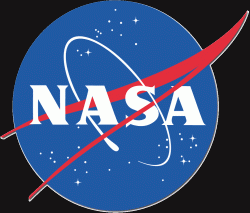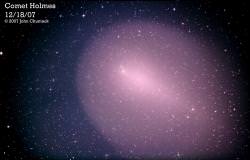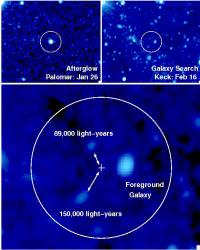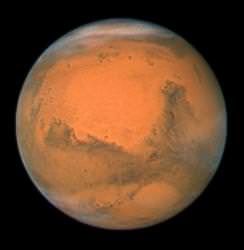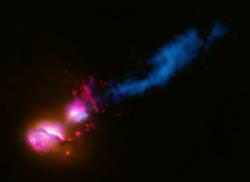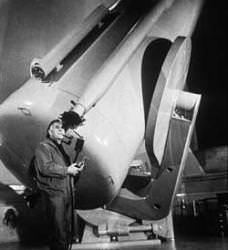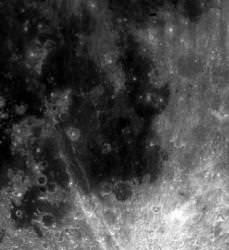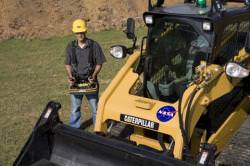Monday, December 17 – Tonight there are craters galore to explore: Plato, Aristotle, Eudoxus, Archimedes… But let’s head to the north of Sinus Medii and have a look at a pair we’ve not yet encountered on our lunar travels – Agrippa and Godin. The larger of the two, Agrippa, measures around 46 kilometers in diameter and drops to a depth of 3070 meters. To the south is Godin, which is somewhat smaller at 35 kilometers in diameter, but a bit deeper at 3200 meters. Note how Godin’s interior slopes towards its central peak.
With deep sky studies improbable for the next few days, why don’t we try taking a look at another interesting variable star? RT (star 48) Aurigae is a bright Cepheid that is located roughly halfway between Epsilon Geminorum and Theta Aurigae. This perfect example of a pulsating star follows a precise timetable of 3.728 days and fluxes by close to one magnitude.
Located 1600 light-years away, RT was first discovered in 1905 by T. H. Astbury of the British Astronomical Association. Like all Cepheids, it expands and contracts rhythmically – for reasons science is not completely sure of. Yet, we do know that it takes about 1.5 days for it to expand to its largest and brightest and 2.5 days for it to contract, cool, and dim.
Tuesday, December 18 – Tonight on the south shore of the emerging Mare Nubium, look for ancient craters Pitatus and Hesiodus right on the terminator. During this phase, something wonderful can happen! If you are at the right place at the right time, sunlight will shine briefly through a break in Hesiodus’ wall and cast an incredible ray across the lunar surface! If you don’t catch it, you can still enjoy one of the few concentric craters on the Moon.
Want a challenging double this evening? Then let’s have a look at Theta Aurigae located on the east side of the pentagonal shape of this constellation.
Located about 110 light-years away, 2.7 magnitude Theta is a four star system, whose members range in magnitude from 2.7 to 10.7. Suited even to a small telescope, the brightest member – Theta B – is itself a binary at magnitude 7.2, and was first recorded by Otto Struve in 1871. The pair moves quite slowly, and may take as long as 800 years to orbit each other at their separation of about 110 AU. The furthest member of this system was also noted by Struve as far back as 1852, but it is not a true member – the separation only occurring thanks to Theta’s own proper motion.
While you are there, be sure to note Theta’s unusual color. While it will appear “white,” look closely at the diffraction caused by our own atmosphere which acts much like a prism… You’ll notice a lot more purple and blue around this star than many others of the same spectral type. Why? Theta is a silicon star!
Wednesday, December 19 – While the mighty Copernicus on the terminator will draw the eye like no other crater tonight, it’s time to pick up another study which you may not have logged – Crater Davy. You will find it just west of the large ring of Ptolemaeus on the northeastern edge of Mare Nubium. It will appear as a small, bright ring, with the large crater Davy A on its southern border. Now skip across the grey sands of Nubium further west and let’s take a look at the crater on the peninsula-like feature Guericke. Named for Dutch physicist Otto von Guericke, this 58 kilometer diameter crater has all but eroded away. Look for a break in its eastern wall and notice how lava flow has eradicated the north!
Now, for apparently no good reason, let’s head for Alpha Persei (Mirfak). While there’s nothing particularly interesting about this 570 light-year distant star, what is incredible is the field in which it resides! Take a look at lowest power with a rich field telescope or binoculars and be prepared to be blown away…
This is the Alpha Persei moving group – a fantastic field of main sequence stars that contains a little over 100 members. Even though it will take 90,000 years before any perceptible change is seen in this bright collection, they are happily moving at a pace of about 16 kilometers per second towards Beta Tauri! Enjoy this fine group also known as Melotte 20…
Thursday, December 20 – Tonight is the peak of the Delta Arietid meteor shower. While most showers are best after midnight, this is an early evening shower that must be viewed before the radiant sets. The fall rate is modest – about 12 per hour.
On the lunar surface, we’re going to head to the deep south as we pick up one of the last of our lunar studies – Longomontanus. Named for the Danish Astronomer Christian Longomontanus (an assistant to Tycho Brahe), this wonderland of details stretches around 145 kilometers across the surface. Look for a great collection of interior craters along its northwest interior wall and note how it has eradicated a much older crater which still shows an edge to the east.
Today marks the founding of Mt. Wilson Solar Observatory. It officially opened its doors in 1904. We also celebrate the birth of Walter S. Adams on this date. Born in 1876, Adams was the astronomer at Mt. Wilson who revealed the nature of Sirius B, the first known white dwarf star. Sirius B was first seen by Alvan Clark in 1862 and most recently, the Hubble Space Telescope precisely measured the mass of B for the first time. While Sirius is far too low at an early hour to study its white dwarf, we can have a look at a similar star when we view Omicron 2 Eridani located roughly a handspan west of Rigel. As the southernmost of the Omicron pair, it is sometimes known as 40 Eridani, and you’ll find it to be an interesting multiple star system that’s very worthy of your time.
Discovered by William Herschel in 1783, this 16 light-year distant system is the eighth nearest of the unaided visible stars. Well spaced from the primary, the companion star is also a double for high powers and will reveal a red dwarf discovered by Otto Struve. Now, look closely at the 9th magnitude B star. This is the only white dwarf that can be considered “easy” for the backyard telescope. Its diameter is only about twice the size of Earth and its mass is about that of our Sun. Power up and locate the 11th magnitude companion…for it’s one of the least massive stars known! And this white dwarf may be the smallest stellar object visible in an amateur telescope – it would be like spotting a tennis ball…on the moon!
Friday, December 21 – Ah, yes… Is there any more beautiful crater on the Moon than graceful Gassendi? While we have visited it before, take the time to power up and enjoy its features. Look for rimae which crisscross the shallow floor, and the strong A crater which mars its northern wall. How many of its interior features can you resolve?
While we’re out, let’s have a look at one of the best known double stars in the night – Gamma Arietis (RA 01 53 31.81 Dec +19 17 37.9).
Also known as Mesarthim, this combined magnitude 4 beauty was unintentionally discovered in 1664 by Robert Hooke who was following a comet. While no real change has been spotted in the more than 343 years since that time, there has been a slight difference detected in the components’ radial velocities. Roughly 160 light-years away, you’ll enjoy this almost matched-magnitude pair of white stars – but look carefully: in 1878, S. W. Burnham found a third star nearby that might not be a physical member, but is also a double!
Saturday, December 22 – Up early? Fantastic! In the pre-dawn hours of this morning, I have a treat for you – the Ursid meteor shower! Cruising around the Sun about every thirteen and a half years, Comet 8P/Tuttle sheds a little skin. Although it never passes inside of Earth’s orbit, some six years later we pass through its debris stream. Not so unusual? Then think again, because it takes as much as six centuries before the meteoroid trail is affected enough by Jupiter’s gravitation to deflect the stream into our atmosphere.
With little interference from the Moon while watching this circumpolar meteor shower, the hours before dawn could see activity of up to 12 per hour. By keeping watch on the constellation of Ursa Major, you just might spot one of these slow moving, 600 year old travelers that make their path only halfway between us and Selene!
Today marks Winter Solstice – for the northern hemisphere, the shortest day and the longest night of the year – and the point when the Sun is furthest south. Now is a wonderful time to demonstrate for yourself our own movements by choosing a “solstice marker.” Anything from a fence post to a stick in the ground will suffice! Simply measure the shadow when the Sun reaches the zenith and repeat your experiment in the weeks ahead and watch as the shadow grows shorter…and the days grow longer!
And be sure to look at the Moon tonight as well, for it is at perigee – its closest point to the Earth. While you might hear a tall tale or two about it being brighter than normal since it is also close to Full, judge for yourself! And be sure to look for signs of libration while you’re there…
Sunday, December 23 – While the Moon will command tonight’s skies, we can still have a look at a tremendous star as we head 150 light-years away to Menkar…
Better known as Alpha Ceti, you’ll find this nearly second magnitude giant orange beauty just west of Orion’s “bow” (RA 03 02 16.77 Dec +04 05 23.0). With even a small telescope, you will also see 5th magnitude 93 Ceti in the eyepiece as well! Although they are not a true physical pair (the blue 93 is 350 light-years further away), they make a wonderful color contrast which is well worth your time. Just think… If 93 were as close as Menkar, it would be 250% brighter. But up the magnification and see if you can spot another true double in the field!
Tonight in 1672, astronomer Giovanni Cassini discovered Saturn’s moon Rhea. Although you will have to wait until a little later in the evening to catch the ringed planet, why not try your hand at finding Rhea as well? A well-collimated scope as small as 4.5″ is perfectly capable of seeing Tethys, Rhea and Dione as they orbit very nearly to the edges of the ring system. All it requires is steady skies and a little magnification!

